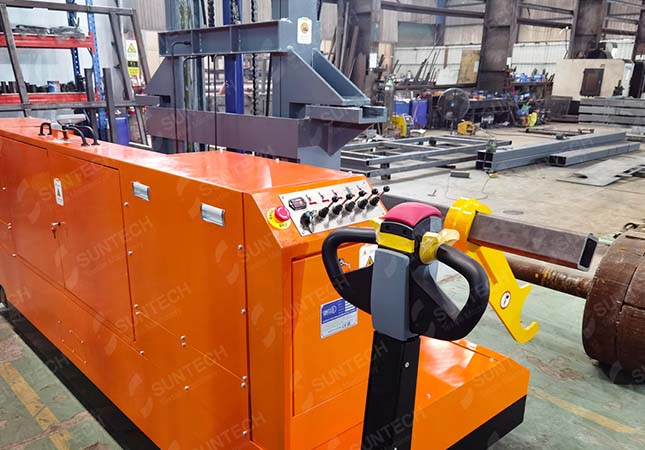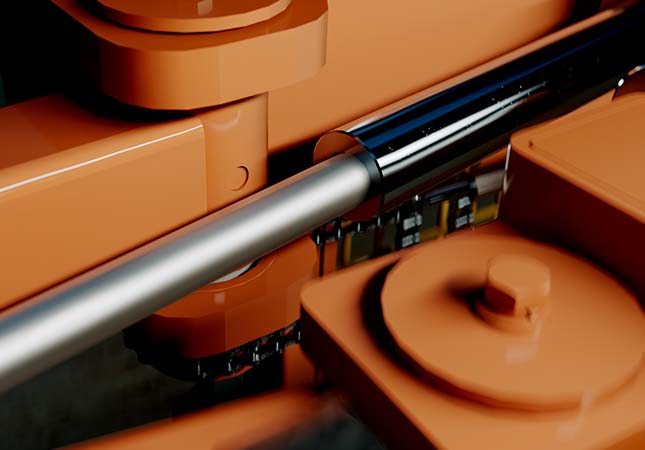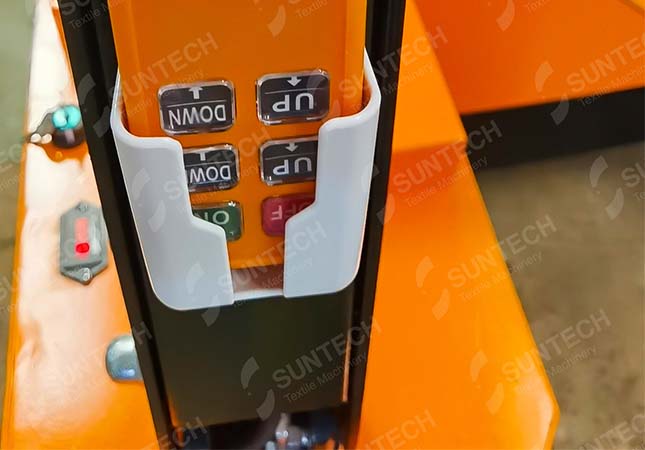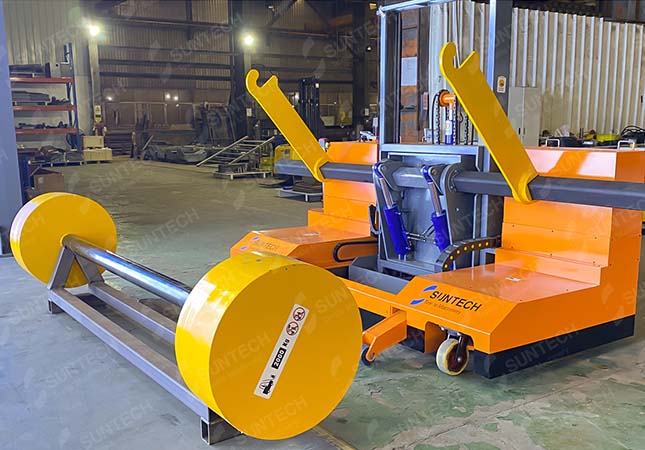The textile industry, being labor-intensive in nature, must prioritize the well-being of its workers in order to enhance labor efficiency and attract a larger workforce. One effective approach to achieve this is through the utilization of material handling equipment, which not only reduce the physical strain on workers but also enhance their safety. Among these equipment, the motorized beam trolley plays a crucial role in facilitating the transformation of beams in the textile industry, thereby providing significant benefits to garment production.

Motorized Beam Trolley Utilization
A motorized beam trolley has emerged as a significant advancement in the textile industry, offering numerous benefits for workers, and contributing to their well-being and overall work environment.
1. Reducing Manual Labor and Physical Strain
Workers have traditionally been tasked with manually handling heavy loom beams, some weighing several hundred kilograms, resulting in physical fatigue, musculoskeletal injuries, and long-term health concerns. However, with the advent of motorized beam trolleys, the need for manual handling of these hefty loads has been significantly reduced or even eliminated. Workers can now simply load the beams onto the trolley and utilize motorized controls to effortlessly move them throughout the facility, effectively alleviating the physical strain on their bodies. The utilization of motorized beam trolleys has the potential to reduce fatigue, minimize injuries, and enhance the overall well-being of workers.
2. Improving Productivity & Efficiency
Motorized beam trolley can benefit workers in several ways. With the automation capabilities of a motorized beam trolley, the handling and transportation of loom beams can be done more quickly and accurately, eliminating or minimizing delays and disruptions in the production process, and allowing workers to meet production targets more effectively. The integration of a motorized beam trolley into the overall factory automation system can also lead to a more synchronized and optimized production process, reducing waiting times and idle times for workers, resulting in increased throughput and output, leading to better job security and stability for workers in the textile industry.

3. Safer Material Handling Conditions
The motorized beam trolley is equipped with advanced safety features, such as collision detection sensors, emergency stop buttons, and safety interlocks, which can prevent accidents and injuries. For example, the collision detection sensors can detect obstacles or other objects in the path of the trolley, automatically stopping or changing direction to avoid collisions, which can prevent accidents that may occur during the manual handling of heavy loads, reducing the risk of injuries for workers. Additionally, the remote monitoring and control capabilities of a motorized beam trolley allow for real-time monitoring of critical parameters, such as load weight, position, and speed, ensuring that the trolley operates within safe limits. This enhances the overall safety of the work environment and helps protect the well-being of textile workers.
The intelligence capabilities of a motorized beam trolley can lead to better working conditions for textile workers. The motorized beam trolley can be equipped with sensors that monitor environmental parameters, such as temperature and humidity, and adjust the operation of the trolley accordingly, helping create a comfortable work environment for workers, optimizing the conditions in which they work, and reducing the risk of discomfort or health issues related to environmental factors. For example, in hot and humid environments, the trolley can be programmed to adjust its speed or operation to prevent overheating, ensuring a safe and comfortable working environment for workers.
4. Providing Ergonomics Workplace
The improvement of ergonomics in the workplace can benefit workers' health and comfort. The design of a motorized beam trolley takes into consideration ergonomic principles, such as height-adjustable controls, easy maneuverability, and intuitive interfaces, which reduce strain on workers' bodies and make their tasks easier to perform. Workers can operate the trolley with minimal physical effort and in a comfortable posture, reducing the risk of musculoskeletal disorders and improving their overall health and well-being.
Economic Status of Motorized Beam Trolley Manufacturing Industry
As an AI language model, I do not have access to real-time data, and my knowledge is based on information up to September 2021. Therefore, I can provide you with a general overview of the economic status of material handling equipment manufacturing based on historical data.

Material handling equipment manufacturing is an important industry that produces machinery and equipment used for moving, storing, and controlling materials in manufacturing, warehousing, logistics, and other industries. Some common examples of material handling equipment include forklifts, conveyor systems, pallet jacks, cranes, and automated guided vehicles (AGVs).
The economic status of material handling equipment manufacturing is influenced by various factors, including global economic conditions, demand from end-user industries, technological advancements, government policies, and trade dynamics. Here are some general trends and insights:
- Market size and growth: The material handling equipment manufacturing industry has witnessed steady growth over the years due to increasing demand for efficient and automated material handling processes in industries such as e-commerce, automotive, food and beverage, and logistics. The global material handling equipment market was valued at around USD 28 billion in 2020 and is projected to grow at a CAGR of around 5% from 2021 to 2028.
- Technological advancements: Material handling equipment manufacturers are constantly innovating and integrating advanced technologies such as automation, robotics, IoT (Internet of Things), and AI (Artificial Intelligence) to improve efficiency, safety, and productivity in material handling operations. This trend is expected to continue, driving demand for advanced material handling equipment.
- Increasing focus on safety and sustainability: As workplace safety regulations become more stringent and environmental concerns gain prominence, material handling equipment manufacturers are increasingly focusing on developing equipment with enhanced safety features and sustainability credentials, such as electric-powered or hybrid-powered equipment, ergonomic designs, and emission-reducing technologies.
- Global trade dynamics: The material handling equipment manufacturing industry is influenced by global trade dynamics, including trade policies, tariffs, and geopolitical factors. Trade disputes and protectionist measures between major economies can impact the supply chain and demand for material handling equipment, as well as production costs.
- Demand from emerging markets: Emerging markets, particularly in Asia-Pacific, Latin America, and the Middle East, are witnessing rapid industrialization, urbanization, and infrastructural development, which are driving demand for material handling equipment. Manufacturers are increasingly focusing on expanding their presence in these markets to capitalize on the growing demand.
- Supply chain disruptions: Material handling equipment manufacturing, like other industries, can be affected by supply chain disruptions, such as shortages of raw materials, components, and disruptions in transportation and logistics. These disruptions can impact production, lead times, and costs, which can in turn affect the economic status of the industry.
In summary, the economic status of material handling equipment manufacturing is influenced by a variety of factors, including global economic conditions, demand from end-user industries, technological advancements, government policies, trade dynamics, demand from emerging markets, and supply chain disruptions. Overall, the industry has been experiencing steady growth, driven by increasing demand for efficient and automated material handling processes, technological advancements, and focus on safety and sustainability. However, it is important to note that the economic status of the industry can vary depending on regional and global factors, and it is advisable to refer to up-to-date data and market research for the most accurate and current information.
ST-MBT-05 Motorized Warp Beam High Lift Trolley
The ST-MBT-05 Motorized Warp Beam High Lift Trolley is designed for transporting upper and bottom beams in weaving machines, loading warp beam storage racks and batch storage racks, mounting sectional beams in knitting machines, and handling non-woven material rolls.

Polyurethane running wheels are mounted in an oscillating manner, resulting in low ground contact pressure and high stability.
Telescopic supporting rollers with safety control ensure safe operation.
AC motor provides low noise, requires no maintenance, and is environmentally friendly.
Gel battery allows for fast charging (3-4 hours), has twice the lifetime of lead acid batteries, and operates in a wide temperature range (-50℃~50℃).
Electric power steering reduces manpower required for steering by one fifth compared to mechanical steering.
Side shift feature allows for safe and efficient positioning of the beam in limited space.
Conclusion
The textile industry is known for its labor-intensive operations, involving the handling and transportation of heavy loads, such as loom beams, which can pose risks to workers' health and safety. However, the motorized beam trolley is a perfect machine in the textile industry to benefit the workers and improve the economic efficiency of the textile industry.
As a reputable textile machinery manufacturer with a rich history in automation and intelligent manufacturing technology of textile and warehousing equipment, SUNTECH Textile Machinery possesses cutting-edge core technologies that are recognized globally.
SUNTECH Textile Machinery leads the textile industry with our innovation and experience! Quotes and Cooperation are Highly Welcome!




